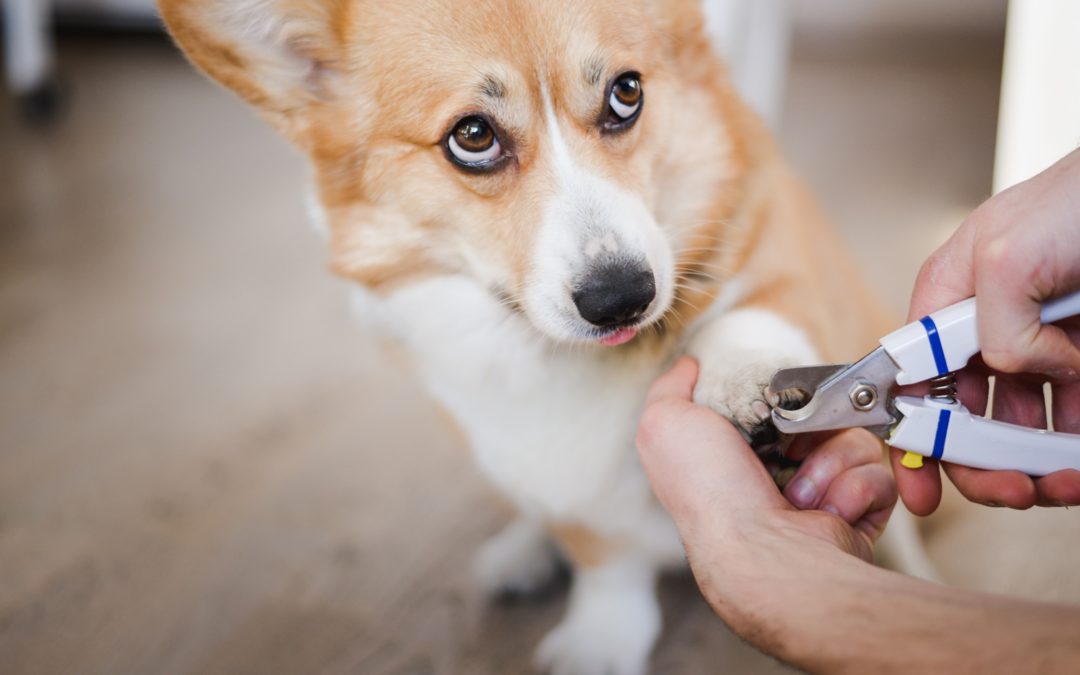When we think of dog grooming, images of fluffy, clean coats and cute haircuts often come to mind. But an essential and often overlooked aspect of dog grooming is nail care. Regularly maintaining your dog’s nails isn’t just about aesthetics — it’s crucial for their health, comfort, and overall well-being.
The Importance of Nail Care for Dogs
- Prevent pain and injury. Long nails can cause discomfort or pain for your dog when they walk, run, or play. The nails can also split or break, leading to bleeding, infection, or inflammation. In some cases, long nails can even curl under and grow into the paw pads, causing severe pain and requiring veterinary intervention.
- Protect your floors and furniture. Overgrown nails can scratch and damage your home’s floors, carpets, furniture, and other surfaces. They can also make a loud clicking noise when your dog walks on hard floors. Fun for tap dancing, not for poor pups!
- Maintain proper posture and alignment. Unclipped nails can affect the shape and conformation of your dog’s toes and feet, affecting their legs and posture. This can lead to joint problems, arthritis, or other musculoskeletal issues in the long term.
- Promote good hygiene. Nails can harbor dirt, bacteria, fungi, or parasites that can cause infections or diseases for your dog or you. Trimming your dog’s nails regularly can reduce the risk of these problems and keep your dog’s paws clean and healthy.
How Often Should You Trim Your Dog’s Nails?
The frequency of nail trims depends on various factors, like your dog’s lifestyle, activity level, and individual nail growth rate. Here are some general guidelines to help you determine how often you should trim your dog’s nails:
- Monthly Trims. As a rule of thumb, most dogs will benefit from having their nails trimmed once a month. This regular schedule helps maintain proper nail length and prevents overgrowth.
- Consider Your Dog’s Lifestyle. Dogs that spend much time walking on hard surfaces, such as pavement or concrete, naturally wear down their nails. These dogs require less frequent trims, possibly every six to eight weeks. On the other hand, dogs with less outdoor activity or those primarily walking on grass or soft surfaces may need more frequent trims every two to three weeks.
- Puppy Nail Care. Puppies have faster nail growth compared to adult dogs. Their nails are also sharp and can cause unintentional scratches. For puppies, it is recommended to trim their nails every one to two weeks. Set them up for success by getting them acquainted with clippers: providing them with treats while touching the clippers to their paws builds trust and a foundation for success!
- Monitor Your Dog’s Nails. Pay attention to your dog’s nails and observe if they are clicking on hard surfaces or becoming snagged on carpets or blankets. These signs indicate that it’s time for a trim.
Signs of Overgrown Nails
It’s essential to be able to recognize the signs of overgrown nails. While the specific length may vary depending on the dog’s breed and individual nails, here are some general indicators that your dog’s nails are too long:
- Clicking Sound. Hearing your dog’s nails clicking on hard surfaces clearly indicates they need a trim.
- Visible Curvature. Long nails may have a noticeable curve extending beyond the toe tip. This curvature indicates that the nails have grown too long and require attention.
- Snags and Tears. If your dog’s nails frequently get caught on carpets, blankets, or other surfaces, it’s a sign that they need trimming.
- Visible Quick. The quick — the sensitive part of the nail that contains blood vessels and nerves — is visible for dogs with white nails. If the nail extends far past the quick, the nails are too long.
How to Trim Your Dog’s Nails
Trimming your dog’s nails can be intimidating, but the right approach and technique can become a stress-free part of your grooming routine.
Step 1: Gather Your Supplies
Before you begin, make sure you have all the necessary supplies within reach. Here’s what you’ll need:
- Dog treats: Use treats as positive reinforcement during the process to keep your dog calm and cooperative.
- Styptic powder or cornstarch/flour: If you accidentally cut the quick, these substances can help stop bleeding.
- Nail clippers or a nail grinder: Choose the tool that you are most comfortable using. Nail clippers, such as guillotine, scissors, or pliers, come in different styles. Nail grinders, like the Dremel, file down the nails gradually.
- An extra pair of hands (optional): Having someone assist you in holding your dog’s paw can make the process easier and safer.
- Patience and a calm demeanor: Dogs can sense your energy, so approaching the task calmly and patiently will help relax your dog.
Step 2: Familiarize Your Dog with the Tools
Introduce your dog to the nail clippers or grinder gradually. Let them sniff and investigate the tools, offering treats and praise to create a positive association. Turn on the grinder or create a similar sound using a dry spaghetti noodle to get your dog used to the noise.
Step 3: Prepare Your Dog’s Paw
Choose a comfortable position for both you and your dog. It’s often helpful to sit beside your dog or sit behind them and flip their paw backward. This allows you a clear view of the nails and keeps your dog’s leg in a natural position.
Step 4: Isolate the Nail
Focus on one toe at a time. Gently hold your dog’s paw and use your thumb to press the pad upward while pushing your finger forward to extend the nail. This will expose the nail and make it easier to trim.
Step 5: Determine the Cutting Point
When cutting your dog’s nails, avoiding the quick — the sensitive part of the nail that contains blood vessels — is crucial. The cutting point will vary depending on the color of your dog’s nails:
- For dogs with white nails, aim to cut just before the quick. You can identify the quick as a pinkish area within the nail. Take small, conservative cuts to prevent accidentally cutting into the quick.
- For dogs with black nails, pinpointing the quick can be more challenging. Cut the nail in small increments, observing the center of the nail. You may notice a chalky, white appearance as you approach the quick. Stop cutting when you see this white area to avoid injury.
Step 6: Trim at a 45° Angle
To ensure the nails are cut correctly, position the clippers or grinder at a 45° angle to the nail. This will create a clean cut and help prevent splintering.
Step 7: Trim the Dewclaws
Remember to trim the dewclaws if your dog has them. Dewclaws are the extra claws located higher up on the leg. They often require special attention as they don’t naturally wear down like the other nails.
Step 8: Use Positive Reinforcement
Throughout the process, offer treats, praise, and reassurance to keep your dog calm and cooperative. This positive reinforcement will help create a positive association with nail trims.
Step 9: Monitor for Any Bleeding
If you accidentally cut into the quick and your dog’s nail starts bleeding, don’t panic. Apply styptic powder, cornstarch, or flour to the bleeding area to stop the bleeding. Press gently and hold for a few seconds until the bleeding subsides.
Regularly trimming your dog’s nails is essential for their health and well-being. Proper nail length can prevent injuries, discomfort, and long-term joint issues. Remember to trim your dog’s nails based on their individual needs and lifestyle, and be vigilant for signs of overgrown nails.
If you’re unsure or uncomfortable, we’re here for you! Book with our professionals in our Grooming Spaw today. Your dog will thank you for their comfort!

